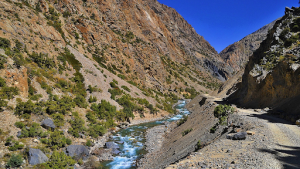Why Uttarakhand wants the Centre to withdraw ILP from Niti and Nelong valley
Why in the news?

- The Uttarakhand government has sought withdrawal of “inner-line permit” (ILP) system in Niti Valley of Chamoli district and Nelang Valley of Uttarkashi district.
- They are asking this removal for better border management and expansion of tourism and other economic activities in villages located there.
- In Uttarakhand, tourists have to obtain ILP for locations near China border, at least in the three districts of Uttarkashi, Pithoragarh and Chamoli.
- Uttarakhand shares a 350-km border with China and a 275-km boundary with Nepal. Five of the state’s 13 districts are border districts.
- Chamoli and Uttarkashi share boundaries with China, whereas Udham Singh Nagar and Champawat have common boundaries with Nepal.
- Pithoragarh is strategically more sensitive as it shares boundaries with both China and Nepal.
What is the Inner Line permit system?
- An Inner Line Permit is a document that allows an Indian citizen to visit or stay in a state that is protected under the ILP system.
- The document is an effort by the government to regulate movement to certain areas located near the international border of India.
- This concept comes from the colonial area. Under the Bengal Eastern Frontier Regulation Act, 1873, the British framed regulations restricting the entry and regulating the stay of outsiders in designated areas.
- This was done mainly to protect British commercial interests from Indians trading within these regions.
- In 1950, the Indian government replaced “British subjects” with “Citizen of India”. This was to address local concerns about protecting the interests of the indigenous people from outsiders belonging to other Indian states.
- Many Northeast states and international bordering states need this ILP.
- It is usually issued by the District Magistrate of the recognised nearby district.
| A similar document is needed for Foreigners to travel to such places, it is called Protected Area Permit. |
About NITI valley

- Niti valley/village is located in Chamoli district of Uttarakhand. Nearby city is Joshimath.
- It is just 40 km away from the Indo- China border.
- Due to ILP restrictions, domestic and foreign travellers are not allowed to stay in the night.
- Being located at 3600 meters altitude, the village remains populated with locals for six months in a year as they migrate to lower altitudes like Joshimath during winters due to adverse weather conditions in higher reaches.
- They return in summers as that is peak tourist season. In the recent season, no one has approached the SDM office for ILP so far. Tourists come to Niti village when they visit Badrinath shrine during Char Dham yatra period.
Nelong valley

- In Nelong valley, there are two villages-Nelong and Jadong — both of which have been abandoned since the 1962 war when the villagers migrated to Dunda and Uttarkashi tehsils . ITBP and the Army are deployed here.
- Jadong is located about 60 km from the China border.
- The maximum number of people allowed are 24 in a day and they cannot stay there at night.
- Around 400 to 450 tourists visit Nelong valley every year and most of them turn up during Char Dham yatra when portals of Gangotri shrine are opened.
What are the benefits of removing the ILP system?
- It will increase economic activities.
- Villages will be rehabilitated and locals could also act as ‘eyes’ and ‘ears’ at the border for surveillance.
- It will also stop outward migration. According to officials in these districts, most of the border villages see outward migration owing to lack of livelihood opportunities.
References:
- https://indianexpress.com/article/explained/what-is-inner-line-permit-and-will-it-address-north-east-states-concerns-over-cab-6145508/
- https://indianexpress.com/article/explained/why-uttarakhand-wants-the-centre-to-withdraw-ilp-from-niti-and-nelong-valley-7223892/
- https://en.wikipedia.org/wiki/Inner_Line_Permit
Subscribe
Login
0 Comments
